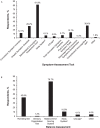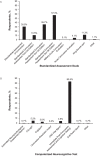Athletic Trainers' Concussion-Assessment and Concussion-Management Practices: An Update
- PMID: 31855075
- PMCID: PMC6961637
- DOI: 10.4085/1062-6050-322-18
Athletic Trainers' Concussion-Assessment and Concussion-Management Practices: An Update
Abstract
Context: Athletic trainers (ATs) are often the first health care providers to conduct concussion assessments and carry out postinjury management. Best practices for concussion evaluation and management have changed rapidly in recent years, outdating previous reports of ATs' concussion practices.
Objective: To examine ATs' current concussion-assessment and -management techniques.
Design: Cross-sectional study.
Setting: Web-based survey.
Patients or other participants: A random convenience sample of 8777 ATs (response rate = 15.0% [n = 1307]; years certified = 15.0 ± 10.6) from the National Athletic Trainers' Association membership.
Main outcome measure(s): Survey Web links were e-mailed to prospective participants, with 2 follow-up e-mails sent by the National Athletic Trainers' Association. The survey collected demographic information, the number of concussions assessed, the concussion-recovery patterns, and the assessment and return-to-participation (RTP) decision-making methods used.
Results: The ATs reported assessing a median of 12.0 (range = 0-218) concussions per year. A total of 95.3% (953/1000) ATs cited clinical examination as the most frequently used concussion-assessment tool, followed by symptom assessment (86.7%; 867/1000). A total of 52.7% (527/1000) ATs described a 3-domain minimum multidimensional concussion-assessment battery. Published RTP guidelines were the most common RTP decision-making tool (91.0%; 864/949), followed by clinical examination (88.2%; 837/949). The ATs with master's degrees were 1.36 times (95% confidence interval [CI] = 1.02, 1.81) more likely to use a 3-domain concussion-assessment battery than ATs with only bachelor's degrees (χ2 = 4.44, P = .05). Collegiate ATs were 2.12 (95% CI = 1.59, 2.84) and 1.63 (95% CI = 1.03, 2.59) times more likely to use a 3-domain concussion-assessment battery than high school and clinic-based ATs, respectively (χ2 = 26.29, P < .001).
Conclusions: Athletic trainers were using the clinical examination, standardized assessment tools, and a 3-domain concussion-assessment-battery approach more frequently in clinical practice than previously reported. However, despite practice improvements, nearly half of ATs were not using a 3-domain minimum concussion-assessment battery. Clinicians should strive to implement multidimensional concussion assessments in their practices to ensure optimal diagnosis and management.
Keywords: diagnosis; evaluation; mild traumatic brain injury; sports medicine.
Figures





References
-
- McCrory P, Meeuwisse W, Dvorak J, et al. Consensus statement on concussion in sport—the 5th International Conference on Concussion in Sport held in Berlin, October 2016. Br J Sports Med. 2017;51(11):838–847. - PubMed
-
- Diagnosis and management of sport-related concussion best practices. National Collegiate Athletic Association Web site. 2019 http://www.ncaa.org/sites/default/files/SSI_ConcussionBestPractices_2017... Accessed January 31.
-
- Suggested guidelines for management of concussion in sports. National Federation of State High School Associations Web site. 2019 https://www.nfhs.org/media/1018446/suggested_guidelines__management_conc... Accessed January 31.
MeSH terms
LinkOut - more resources
Full Text Sources
Medical

